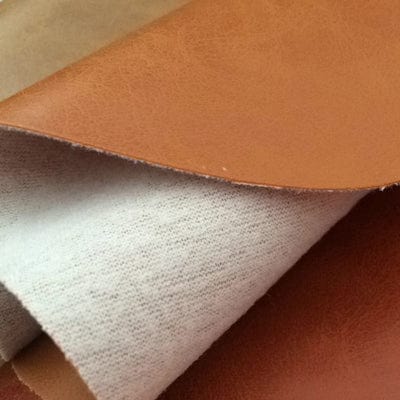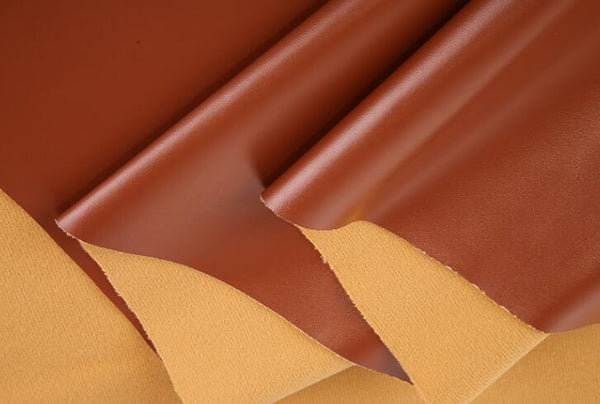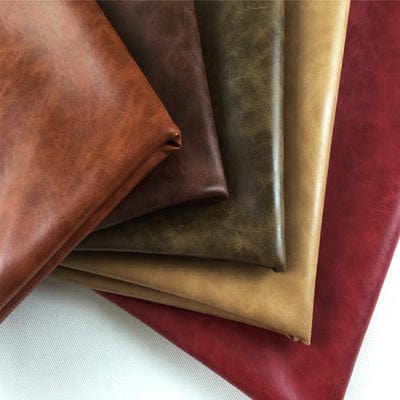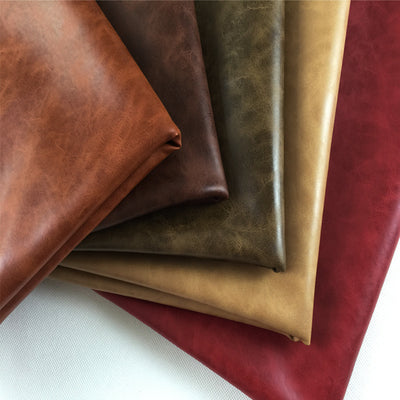Your cart is currently empty
What Is PU Leather? Is It The Real Deal?
There are numerous goods marketed as "leather," but do you know the distinction between PU (polyurethane) leather and genuine leather? Please allow us to explain. Genuine leather is unquestionably a better material for a variety of products. It is renowned for both its durability and appealing appearance.
There are lots of low-cost imitations that are designed to seem just like the real thing. These products are composed of inferior materials that won't hold up over time. Understanding the distinction between real leather and imitation products, particularly PU leather, is crucial for consumers.

What is PU leather?
PU leather, commonly referred to as synthetic leather, is an imitation of genuine leather made from polyurethane, a resin having properties comparable to those of leather without using any animal products. 100% PU leather is synthetic leather made without using any animal products. Vegan leather is regarded as being made of PU.
The most popular method for producing PU leather is to cover a fiber foundation with a polyurethane coating or a plastic polyurethane cover (generally polyester). To create "double-cast" leather, PU leather and real leather can be mixed together. A base of divided actual leather may be used in "double-cast" leather, which may have a PVC or PU layer applied on top.
Although PU leather typically weighs less than real leather and generally has the same texture, it is less resilient and more prone to tearing than real leather. Because it is more UV-resistant, it is widely used to cover faux leather furniture and car seats.
PU leather is less breathable than genuine leather. It is, nevertheless, more breathable than other synthetic leather varieties, including PVC. PU material will retain a consistent appearance and feel throughout its life, in contrast to genuine leather, which tends to grow more appealing and softer over time.

How can you identify PU Leather?
It is vital to know how to tell the difference between PU leather and real leather, depending on whether you're looking for either. If you are purchasing a leather bag, the quickest way to tell the difference is to read the tag or description. Knowing the differences will be helpful because products could occasionally not have a tag.
The cost will be the main distinction you notice. Since it is easier to create and considerably less expensive material, PU leather will often be less expensive than genuine leather. Since PU leather is made of synthetic material, it will have a distinct fragrance. Real leather will not smell like plastic or chemicals, but PU will.
It is very simple to determine whether the leather is real or phony by performing a water test. Genuine leather will absorb the water, despite the fact that it is not advisable to test an item you do not already own with water. You might be able to spot the difference just by glancing at the goods if you have a keen eye. Our bags have a vintage appearance since real leather will have certain flaws and a true texture. PU leather will appear fake and almost have a perfect, patterned texture look.
Moreover, leather can be made to have a variety of animal looks and textures. Because PU leather is not created from genuine animal hide, it won't last as long as real leather, which is its main drawback. It will also probably look a lot less vintage, which is one of the main reasons people choose leather in the first place.

Numerous terms, such as "leatherette," "faux leather," "vegan leather," "PU leather," and "pleather," are used to describe artificial leather.
Describe faux leather
Many names, including faux leather, know as artificial or synthetic leather. These terms are used to designate certain applications for synthetic leather products. The two main materials used to create imitation leather are polyurethane ("PU") and polyvinyl chloride (PVC).
Are PU leather and synthetic leather the same thing?
Yes, to answer briefly. PU leather, commonly referred to as synthetic leather, is a man-made substitute for genuine leather. Although it has the same feel and appearance as real leather and appears the same, it doesn't harm animals in any manner. However, it will eventually start to crack and does not last nearly as long as genuine leather.

Leather
There are several factors to take into account while buying leather goods. What kind of leather you want is, of course, the most fundamental query. Of course, there is genuine leather, but there are also imitation leather-looking synthetic materials like pleather and PU leather, which aren't actually leather.
PU Leather Pros:
- Since PU leather costs less to create, it is also less expensive to buy.
- PU Leather is typically simple to clean because it is comprised of plastic.
Cons of PU Leather: PU leather is short-lived
- PU Leather does not bend well and, over time, will crack and peel.
- No patina forms on PU Leather.
Peeling PU Leather
Genuine leather does not flake, peel, or chip. While peeling leather may occasionally only be an unstable finish or aftermarket paint, it is more frequently a cheap polyurethane (PU) synthetic material known as faux leather.
How can PU Leather be kept from cracking?
PU leather begins to crack and become sticky in certain places. Therefore, regular upkeep and cleaning are crucial. PU leather should dust when necessary using a dry or slightly moist lint-free towel.
How does PU leather compare to genuine leather?
Synthetic polymers, which are used to make PU leather, are produced by mixing plasticizers, colorants, and oils with polymer resin. Real leather is, without a doubt, superior to PU leather. Real leather is more durable in addition to having a nicer appearance. Real leather has a lot of personality and ages wonderfully. On the other hand, PU leather is less robust and will eventually peel and fracture.
The main benefits of PU leather are its reduced cost, simplicity of upkeep, and ability to mimic the look and feel of numerous animals. Because PU leather is not created from genuine animal hide, it won't last as long as real leather, which is its main drawback. It will also probably look a lot less vintage, which is one of the main reasons people choose leather in the first place.
How can PU Leather be cleaned?
You should initially pick a mild detergent for the fabric for the majority of stains. Some of the more potent cleansers can even harm faux leather! It's better to use a mild detergent and a sponge to clean up specific spills like coffee or juice.
- A tablespoon of detergent and enough water to fill the spray bottle should be combined.
- Shaking ferociously
- Onto a fresh towel, mist the mixture.
- Wipe the stain away.
- Serious stains can be removed with gentle scrubbing.
Real leather, what is it?
In our situation, cowhide is used to create real leather, which needs to be tanned to prevent degradation and create usable leather. An accessory constructed of this material can endure between 10 and 20 years if maintained properly. Genuine leather is much more breathable and humidity-resistant than most artificial leathers, which can start to crack and warp in as little as a few years. It is also more difficult to tear or puncture.
In comparison to PU leather, leather requires a little more upkeep. You must use a special leather cleaner if the leather becomes soiled with sweat or oil. Leather can be cleaned with soap or water and a damp cloth. Genuine leather may occasionally need to have a leather conditioner treated to maintain it supple; otherwise, it may stiffen up and become brittle. This happens when leather's natural oils deteriorate with time.
Sorts of leather the most popular leather type is undoubtedly top grain. This is due to top-grain leather's superior appearance above all other varieties.
What are the Benefits of Genuine Leather?
Is it truly worth spending the extra money to buy an actual product instead of one of the many available knockoffs? What benefits specifically come with buying real goods? In addition to their outstanding durability, the following are a few factors that influence how many people opt for genuine goods over cheaper imitations:
- Genuine leather resists water.
- It is permeable to air.
- Real leather's classic appearance will never go out of style.
- Genuine leather is a considerably more resilient substance and will endure over time.
- Genuine leather matures incredibly well.
Various types of leather
The use of genuine leather has numerous advantages. Genuine leather has a reputation for being significantly more resilient to wear and tear than other materials. This is because leather naturally contains oils that make it robust and flexible.
Real leather also has an attractive appearance result, which is difficult to replicate with materials like vinyl or plastic. Pure leather also has a tendency to age wonderfully, giving whatever it is used for a distinctive appearance.
- Vegan leather
Synthetic leather, PU leather, and vegan PU leather are further names for vegan leather. Vegan leather is created from either plastic- or plant-based materials, as opposed to real leather, which is made from animal hide. Despite having a similar appearance to genuine leather, vegan leather is very different from the latter.
- Unreal Leather
Although it feels and looks like leather, is it actually made of leather? Faux leather is not leather, despite its name. In conclusion, the word "faux" is French for "fake." Faux leather is hence artificial leather. Many people also call it vegan leather or leatherette. It is inferior to things made of genuine leather because it is phony. But it does have certain benefits. Learn about the benefits and drawbacks of imitation leather as we go.
- Faux leather
Since no actual animals are harmed during the production of faux leather, it is regarded as vegan leather. Therefore, many people buy faux leather as an animal-free substitute for owning goods like purses and furniture.
However, it's crucial to take into account the environmental risk that pvc leather poses. Many question the ecological effects of faux leather because it is made from a plastic substrate like PVC. However, many artificial leather manufacturers are developing to minimize their negative environmental effects.
- Bicast leather or bonded leather
Leather scraps, shredded leather, leftover leather, and a bonding agent are all used to create bonded leather (typically plastic). After that, it is pressed into sheets that can either be used directly for upholstery or utilized to create finished leather products. For many years, there has been debate concerning the use of bonded leather.
Many people do not believe it to be real leather, despite the fact that it is more affordable, simpler to create, and closer to the appearance and feel of genuine leather. The main cause of this is that bonded leather does not originate from the animal; rather, it is a manufactured material that frequently lacks toughness and does not appear like genuine leather. It is also known as split leather on occasion.
- Premium Leather
The second-highest grade of leather among all leather varieties is top-grain leather. Faux leather isn't included because it's not actually leather.
Additionally, top-grain leather is perhaps the type of leather that is utilized the most. This is due to top-grain leather's superior appearance above all other varieties.
- Leather with full grain
The greatest sort of leather is full-grain leather. Additionally, only the best animal skins can be used to create full-grain leather. Due to its high quality, full-grain leather may also be pricey for this reason.
Full-grain leather, like top-grain leather, is made from animal skins. However, full-grain leather will not be subjected to the sanding, burning, or shaving procedure. Therefore, it is safe to assume that full-grain leather is constructed using the complete grain's thickness. The pores, grains, scars, and other textures are all still present. In all of our goods, Steel Horse Leather only employs full-grain leather.
Does PU leather last?
PU leather is a lovely material frequently used for chair and sofa covers. Homeowners worldwide adore it since it is strong, long-lasting, and less expensive than genuine leather. You can use a PU leather cleaning to keep your PU leather in good condition. When purchasing consumer goods using PU, such as leather furniture, the price tag is the best indicator of whether the leather is real or PU. PU leather is a significantly more affordable choice.
The cost of PU leather is higher because it is cheaper to create. The smell can also be used to determine whether the leather is PU. There will be a little chemical or plastic smell to the new PU leather.
PU leather may also have a texture that seems a little fake and a different appearance from genuine leather. It will have a consistent pattern and texture that is nearly flawless. An accessory constructed of this material can endure between 10 and 20 years if maintained properly.
Is PU leather better than synthetic leather?
According to research, the term faux leather originally meant false leather in French. To simulate the premium appearance and feel of genuine leather created from an animal hide, man-made material was employed.
It is water-resistant, simple to clean, and has a rough appearance that occasionally resembles embossing. The smoothness and similarity to real leather in both types of leather can deceive you, and it will truly take your breath away.
PU leather, often known as synthetic leather, is what distinguishes the two types of leather. The polyurethane used to manufacture the leather has a comparable feel and appearance to leather without harming any animals. The primary goal of its product is that PU is an artificial substance made without using animals.
While used polyester-based fabric to manufacture imitation leather, it is a high-quality fabric that delivers the elegance and beauty of real leather while being soft and long-lasting because it is composed of ultra-leather imitation leather. The fabric has a polyvinyl chloride (PVC), wax, dye, or polyurethane texture and imitation leather finish.
It is intended to resemble genuine leather, although the synthetic leather's surface is homogeneous. Because some varieties of imitation leather are referred to as bicast, which means they contain real leather, they differ from PU leather. Considering that bi-cast leather contains natural leather. It possessed the qualities of both varieties of leather. PU leather is entirely vegan because it is constructed entirely of synthetic materials and contains no actual leather.
Although it won't be as durable as genuine leather, faux leather, also known as PU leather, will be more resilient than bonded leather. In addition to being readily punctured and crackable over time, PU leather is not breathable. In contrast to bonded leather, PU leather has stain and fade resistance.
Conclusion
PU leather is in high demand these days. It is good enough to make products. If you want to know some interesting things about PU leather, this article is for you.
Shop our collection of:
Leather Embossed Journals | Refillable Leather Journals | Leather Sketchbook | Customized Leather Portfolios | Leather Refillable Planner | Leather Bags For Men | Leather Bags For Women
Related Blog Posts:




